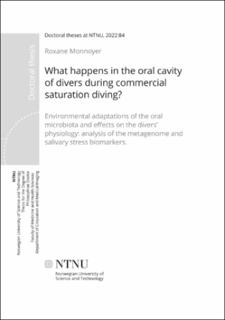| dc.contributor.advisor | Eftedal, Ingrid | |
| dc.contributor.advisor | Haugum, Kjersti | |
| dc.contributor.author | Monnoyer, Roxane | |
| dc.date.accessioned | 2022-03-23T10:05:57Z | |
| dc.date.available | 2022-03-23T10:05:57Z | |
| dc.date.issued | 2022 | |
| dc.identifier.isbn | 978-82-326-6054-4 | |
| dc.identifier.issn | 2703-8084 | |
| dc.identifier.uri | https://hdl.handle.net/11250/2987042 | |
| dc.description.abstract | Commercial saturation diving has been used by the offshore oil and gas industry in the North Sea since the 1960s to perform long-term underwater work safely and efficiently. The highpressure oxygen conditions of the confined environment of the hyperbaric chamber bring challenging restraints, whether physiological or technical. Studies of basic pathophysiology in saturation diving have usually been done on the blood. However, phlebotomy is an invasive method and may add unnecessary supplementary risks of stress or infection for the divers. Using saliva not only makes it possible to bypass the technical problems specific to blood testing; it also gives access to information on the microorganisms present in the oral cavity. The variety of microorganisms living in and on the diver’s body, named microbiota, may influence the diver’s state of health. During saturation diving operations, microorganisms inhabiting the oral cavity of the divers are also exposed to the hyperbaric hyperoxic environment. The acclimatization of these microorganisms to the hyperbaric environment can impact central metabolic processes involved in the maintenance of physiological and metabolic homeostasis of the diver.
The thesis addresses the effects of prolonged exposure to the high partial pressure of oxygen on the oral microbiota of thirty occupational saturation divers. Using 16S rRNA gene sequencing, we described the bacterial diversity and changes in the bacterial composition of the oral cavity before, during, and after a 28-day heliox commercial saturation dive at 200 meters deep (paper I). Based on the sequencing data, we used a computational approach to estimate the functional activities associated with the bacterial composition of the oral microbiota during and after saturation diving compared to a pre-dive baseline (paper II). Additionally, we assessed the effects of saturation on the physiology of nine divers by measuring levels of salivary biological markers of oxidative stress and inflammation collected throughout a 14-day heliox saturation dive to a depth of 80 meters (paper III).
Acclimatization of the oral microbiota to the high partial pressure of oxygen during hyperbaric saturation was demonstrated by a transient change in the relative abundance of aerobic versus anaerobic bacteria, resulting in reduced bacterial diversity (paper I). The shift between bacterial communities led to transient changes in several metabolic pathways involved in their survival and growth. A decrease observed in vitamin B12 biosynthesis reinforces the findings of the literature about requirements in vitamin B12 supplementation as part of the diver’s diet. This supplementation could help correct the mild anemia observed in the divers after saturation (paper II). Finally, the salivary biomarkers analysis showed an increased production of salivary inflammatory mediators probably reflecting the response of the autonomous nervous system to the high partial pressure of oxygen. The signs of inflammatory responses strengthen what had already been demonstrated on the divers’ blood in previous saturation diving studies (paper III).
In conclusion, this work highlighted the impact of saturation diving on divers both on their oral microbiota and on their physiology via oral stress biomarkers. Our results show that the oral microbiota and its functional activity changed during saturation. Furthermore, we showed that saliva could be used to monitor the physiological stress experienced by the divers during saturation diving operations. | en_US |
| dc.language.iso | eng | en_US |
| dc.publisher | NTNU | en_US |
| dc.relation.ispartofseries | Doctoral theses at NTNU;2022:84 | |
| dc.relation.haspart | Paper 1: Monnoyer, Roxane; Haugum, Kjersti; Lautridou, Jacky; Flatberg, Arnar; Hjelde, Astrid; Eftedal, Ingrid. Shifts in the oral microbiota during a four-week commercial saturation dive to 200 meters. Frontiers in Physiology 2021 https://doi.org/10.3389/fphys.2021.669355 This is an open-access article distributed under the terms of the Creative Commons Attribution License (CC BY) | en_US |
| dc.relation.haspart | Paper 2: Monnoyer, Roxane; Eftedal, Ingrid; Hjelde, Astrid; Deb, Sanjoy Kumar; Haugum, Kjersti; Lautridou, Jacky. Functional profiling reveals altered metabolic activity in divers’ oral microbiota during commercial heliox saturation diving. Frontiers in Physiology 2021 ;Volum 12. https://doi.org/10.3389/fphys.2021.702634 This is an open-access article distributed under the terms of the Creative Commons Attribution License (CC BY). | en_US |
| dc.relation.haspart | Paper 3: Monnoyer, Roxane; Lautridou, Jacky; Deb, Sanjoy Kumar; Hjelde, Astrid; Eftedal, Ingrid. Using salivary biomarkers for stress assessment in offshore saturation diving: A pilot study. Frontiers in Physiology 2021 ;Volum 12. https://doi.org/10.3389/fphys.2021.791525 This is an open-access article distributed under the terms of the Creative Commons Attribution License (CC BY). | en_US |
| dc.title | What happens in the oral cavity of divers during commercial saturation diving? Environmental adaptations of the oral microbiota and effects on the divers’ physiology: analysis of the metagenome and salivary stress biomarkers. | en_US |
| dc.type | Doctoral thesis | en_US |
| dc.subject.nsi | VDP::Medical disciplines: 700 | en_US |
